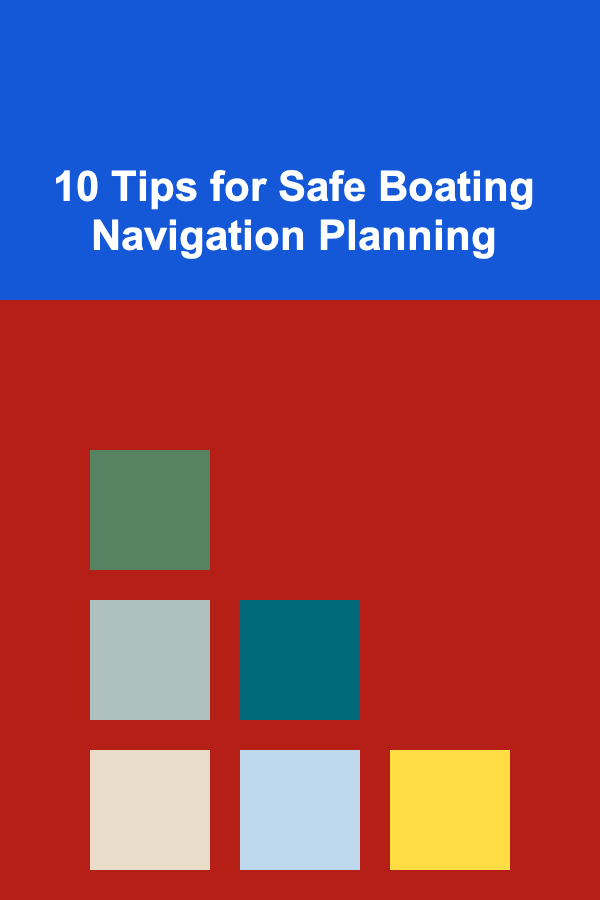
10 Tips for Safe Boating Navigation Planning
ebook include PDF & Audio bundle (Micro Guide)
$12.99$10.99
Limited Time Offer! Order within the next:

Boating can be one of the most enjoyable and liberating activities, whether it's for leisure, sport, or transportation. However, it is crucial to understand that it also requires careful planning and navigation. A safe boating experience hinges on your ability to navigate water bodies with accuracy and caution. With the right knowledge, tools, and preparation, you can reduce risks and enjoy your time on the water without unnecessary worries.
This article outlines ten essential tips for safe boating navigation planning that every boater should follow to ensure both their safety and the safety of others on the water.
Know Your Vessel and Its Capabilities
Before venturing out onto the water, you need to have a good understanding of your boat. This means knowing its dimensions, weight, hull type, and maximum speed. Understanding how your boat handles in different weather conditions, as well as its limitations, is essential for safe navigation.
For example, some boats are designed for calm, inland waters, while others can handle rougher seas. Knowing your boat's strengths and weaknesses will help you avoid navigational mishaps that could occur when pushing the boat beyond its limits.
Tip: Regularly maintain your boat to ensure it's functioning at optimal levels and to avoid mechanical failures that could jeopardize your navigation.
Understand the Waterway Conditions
Water conditions can vary significantly, depending on the location, time of year, and weather patterns. Navigating in open seas, for instance, requires a different set of skills than navigating through shallow rivers or lakes. It's important to understand the type of waterway you will be navigating, including tides, currents, and potential obstacles like rocks, sandbars, and submerged objects.
Check tide charts, current predictions, and weather reports before departure. Pay close attention to warnings, such as hazardous winds, rough waters, or storms, which could affect navigation.
Tip: Utilize local marine charts and apps that provide real-time weather data and tide information to ensure you're aware of any potential hazards before heading out.
Use Reliable Navigation Tools
Traditional maps and charts are still valuable tools for navigation, but technology has greatly improved the accuracy and efficiency of boating navigation. Equip your vessel with the proper navigation systems, such as GPS devices, chartplotters, radar, and depth finders. These tools can provide real-time data, help you track your position, and alert you to nearby hazards.
When using GPS or digital charts, ensure that they are regularly updated to reflect any changes in the waterway, such as new channels or hazards. Additionally, ensure your devices are fully charged or powered before heading out.
Tip: Familiarize yourself with the navigation equipment on your boat and practice using it in calm, familiar waters before navigating in more challenging environments.
Plan Your Route in Advance
Planning your boating route before departure is crucial for safe navigation. Study the waterway maps and charts, identify potential hazards, and chart a course that avoids known dangers such as shallow waters, rocks, or areas with heavy boat traffic.
Also, consider your fuel capacity and the distance you plan to travel. It's important to know where safe anchorages or fueling stations are along your route, especially if you plan to travel long distances.
Tip: If you're unfamiliar with the area, consider consulting local boaters or harbor masters for advice on the safest and most efficient routes.
Know the Navigation Rules and Regulations
Different bodies of water have different rules and regulations regarding navigation, which may include speed limits, restricted areas, and specific routes for vessels. Familiarize yourself with the local boating regulations and the "Rules of the Road" for boating, which include guidelines for giving way, signaling, and maintaining proper lookout.
In many areas, boats are required to carry certain safety equipment, such as life jackets, fire extinguishers, and distress signals. Know the requirements for the region where you are boating, and ensure your vessel is properly equipped.
Tip: Always carry a boating manual and any local regulations when out on the water, and ensure your crew is familiar with them.
Be Prepared for Emergencies
Accidents and emergencies can happen unexpectedly, which is why being prepared is key to a safe boating experience. In addition to your navigation tools, you should have an emergency plan in place. This includes knowing how to call for help, understanding how to use distress signals, and having a first aid kit readily available.
Make sure all passengers are aware of emergency procedures, and ensure everyone knows where the safety equipment is located. Equip your boat with an emergency communication device like a VHF radio or satellite phone to ensure you can call for help in case of an emergency.
Tip: Regularly conduct emergency drills with your crew so everyone knows what to do in case of a real emergency.
Monitor Weather and Environmental Changes
Weather can change rapidly, especially when out on the water. Sudden storms, fog, or winds can make navigation challenging and dangerous. Always monitor weather forecasts before and during your trip, and remain alert to changes in the environment, such as shifting winds, cloud cover, or increasing waves.
If you're caught in inclement weather, seek shelter as soon as possible. Avoid navigating in adverse weather conditions, such as thunderstorms or fog, as they can severely reduce visibility and make safe navigation difficult.
Tip: Always have access to weather apps, a barometer, or a weather radio to stay updated on changing conditions while out on the water.
Practice Safe Speed and Distance
Navigating at the appropriate speed is essential for safe boating, especially when dealing with narrow or congested waterways. Too much speed can result in difficulty maneuvering around obstacles, while too little speed can leave you vulnerable to drifting or being caught in currents.
Maintain a safe distance from other vessels, structures, and potential hazards. Keep in mind that larger vessels may have difficulty maneuvering in tight spaces, and give them ample room to pass. Also, when navigating through areas with other boaters, be sure to follow the "slow-no-wake" zones and respect the speed limits posted on the water.
Tip: Always adjust your speed based on the conditions of the waterway, your vessel's capabilities, and the proximity of other boats.
Always Maintain a Lookout
Having a dedicated lookout is an essential practice in safe boating navigation. The person at the helm of the boat may not always have a clear view of potential obstacles or other vessels, so having a lookout helps ensure that hazards are spotted early.
The lookout should constantly scan the horizon, monitor the boat's surroundings, and be aware of any changes in the water or other vessels' movements. Look for floating debris, buoys, other boats, and changes in water depth.
Tip: Rotate the lookout duties among your crew to ensure no one becomes fatigued or misses important signs while navigating.
Be Ready to Adjust Your Plan
Boating navigation requires flexibility. Unexpected changes in weather, tides, or obstacles can make your original plan less viable. Be prepared to adjust your route if necessary. Avoid taking unnecessary risks, and if the conditions become too challenging, consider delaying your trip or seeking safer waters.
Be honest with yourself about the conditions you're facing and don't hesitate to turn back or wait for better conditions if necessary. Your safety and the safety of your crew should always come first.
Tip: Always have a contingency plan in place in case you need to alter your course, including alternative routes and nearby shelters or ports.
Conclusion
Safe boating navigation planning is a comprehensive process that involves understanding your boat, the waterways, the conditions, and regulations around you. By planning ahead, staying prepared, and making careful decisions while navigating, you can ensure that your time on the water is enjoyable and safe.
From using the latest navigation tools to monitoring weather conditions and maintaining proper lookout, these tips will help guide you through your boating journey with confidence. Whether you're a seasoned boater or just starting out, always prioritize safety, plan accordingly, and be ready to adapt when necessary. The more you prepare and stay vigilant, the safer your boating experience will be.
Reading More From Our Other Websites
- [Organization Tip 101] How to Save Money on Basement Waterproofing Without Compromising Quality
- [Soap Making Tip 101] From Kitchen to Bath: Adult-Focused Recipes for Artisan Scented Bars
- [Organization Tip 101] How to Create a Holiday Decoration Inventory List
- [Home Cleaning 101] How to Clean an Oven: Easy Methods for a Sparkling Clean
- [Personal Care Tips 101] How to Use Face Oil for a Relaxing Skincare Ritual
- [Home Storage Solution 101] How to Design a Functional Laundry Room with Storage Solutions
- [Home Staging 101] How to Avoid Common Home Staging Mistakes to Avoid That Can Derail Your Sale
- [Home Security 101] How to Identify and Address Home Security Blind Spots
- [Organization Tip 101] How to Organize Your Laundry Supplies for Efficiency
- [Organization Tip 101] How to Organize Your Closet for a Quick Morning Routine

How to Build a Personal Budget That Works for Your Lifestyle
Read More
How to Evaluate Cryptocurrency Projects Before You Invest
Read More
How to Maintain Content Consistency While Scaling Your Strategy
Read More
How to Store Books in Small Spaces
Read More
How to Build a Profitable Coaching Business
Read More
How to Use a Self-Care Checklist for Seasonal Affective Disorder (SAD)
Read MoreOther Products

How to Build a Personal Budget That Works for Your Lifestyle
Read More
How to Evaluate Cryptocurrency Projects Before You Invest
Read More
How to Maintain Content Consistency While Scaling Your Strategy
Read More
How to Store Books in Small Spaces
Read More
How to Build a Profitable Coaching Business
Read More